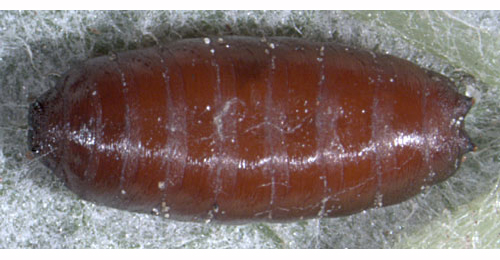|
||||||
|
Pegomya
laticornis (Fallén, 1825) Musca
laticornis Fallén, 1825. Monogr. Musc. Sveciae
9: 86 |
||||||||||||||||||||||||||||||||||||||||||||||||||||||||||||||||||
|
Leaf-miner: Blotch mine restricted by leaf veins; frass in irregular lumps. The mine begins at the leaf underside, close to a heavy vein, at a white egg shall that remains in place even in fully developed mines. Often several eggs at distances of about 1 cm along the vein. Each larva makes a large blotch without a preceding corridor. Almost all frass is concentrated in a big mass in the the initial part of the mine. In this part the mine is lower-surface (therefore one sees green leaf tissue overlying the frass mass), but further on the mine is upper-surface, in fact almost full depth and very transparant. In fresh mines remnants of the parenchyma are visible as secondary feeding lines. Often the older mines coalesce. Pupation outside the mine (Bladmineerders van Europa). Forms a large blotch mine, which may contain several larvae, on the leaf upper surface. The white eggs are laid close to a vein (British leafminers). Larva: The larvae of flies are leg-less maggots without a head capsule (see examples). They never have thoracic or abdominal legs. They do not have chewing mouthparts, although they do have a characteristic cephalo-pharyngeal skeleton (see examples), usually visible internally through the body wall. The larva is illustrated in Bladmineerders van Europa. Puparium: The puparia of flies are formed within the hardened last larval skin or puparium and as a result sheaths enclosing head appendages, wings and legs are not visible externally (see examples). The puparium is illustrated in Bladmineerders van Europa.
Comments: Ackland in Chandler (1978) did not indicate whether his host record was British or Foreign and is therefore included under 'Hosts in Britain' and 'Hosts elsewhere Hosts in Great Britain and Ireland:
Hosts elsewhere:
Time of year - mines: June-July (Hering, 1957). Summer (British leafminers). Time of year - adults: Currently unknown. Distribution in Great Britain and Ireland: England including Warwickshire (Merevale) (Robbins, 1991: 110); Berkshire, Cambridgeshire, Cumnerland, Herefordshire, North Somerset, Nottinghamshire, Oxfordshire, Shropshire, South-west Yorkshire and West Gloucestershire (NBN Atlas). Distribution elsewhere: Widespread in continental Europe including The Netherlands (Bladmineerders van Europa), Austria, Czech Republic, Denmark, ? Finland, French mainland, Germany, Poland, Romania, Russia - Central and Sweden (Michelsen in Fauna Europaea). NBN Atlas links to known host species:
British and Irish Parasitoids in Britain and elsewhere: Currently unknown. |
| Last updated 28-Mar-2018 Brian Pitkin | ||

